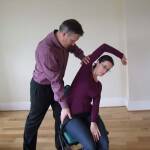Booking Information:
Treatment: £45 per hour
Contact Larry on:
07952923884


Booking Information:
Treatment: £45 per hour
Contact Larry on:
07952923884
Recommended for:
Clients with back, neck and shoulder problems, stroke victims and other ailments see text.
ACTIVE ISOLATED STRETCHING
Discovering AIS has been the second major turning point in my career as a sports and remedial masseur.
I initially came to AIS with a great deal of skepticism, and was convinced only by direct experience. I’ve seen results myself that I never thought possible: after training in Sarasota with Aaron Mattes, I worked in Aaron’s clinic and was amazed by what I experienced. I saw people with chronic problems that are usually attributed to the inevitable effects of aging simply disappear. Conditions that I thought of as untreatable, including declines in flexibility due to aging, degenerative arthritis, or serious injury and muscular dysfunction due to progressive degenerative diseases such as multiple sclerosis (MS) or Parkinson’s disease. I’m happy to say that AIS has proven me wrong.
How AIS Works
AIS movements are precisely targeted to stretch individual muscles and parts of muscles, rather than larger muscle groups. There are AIS protocols for every primary muscle in the body, amounting to more than 170 separate stretches. Using different combinations of these stretches, we can develop customized regimens tailored to the specific needs of any client.
What is involved?
The movements involved in AIS are quite gentle, never approaching a muscle’s maximum sustainable force
How AIS Avoids Stretch reflex
The key to avoiding the stretch reflex altogether is to hold a stretch for only a short time — no more than two seconds. Traditionally, exercise specialists have recommended holding stretches for much longer periods of time, up to 60 seconds. (This is referred to as static stretching.) However, research has shown that such prolonged stretching initiates the stretch reflex, decreases blood flow within the tissue, and leads to a build up of waste products, such as lactic acid, that contribute to muscle fatigue and soreness. When people stretch in this way, they’re working against themselves, causing a contraction of the very muscles they’re trying to lengthen (sort of like trying to drive a car with the hand brake on). As a result, the tendons and ligaments get stretched more than the muscles, which can lead to tendon irritation and even laxity, and thus predispose these structures to future injury.
”